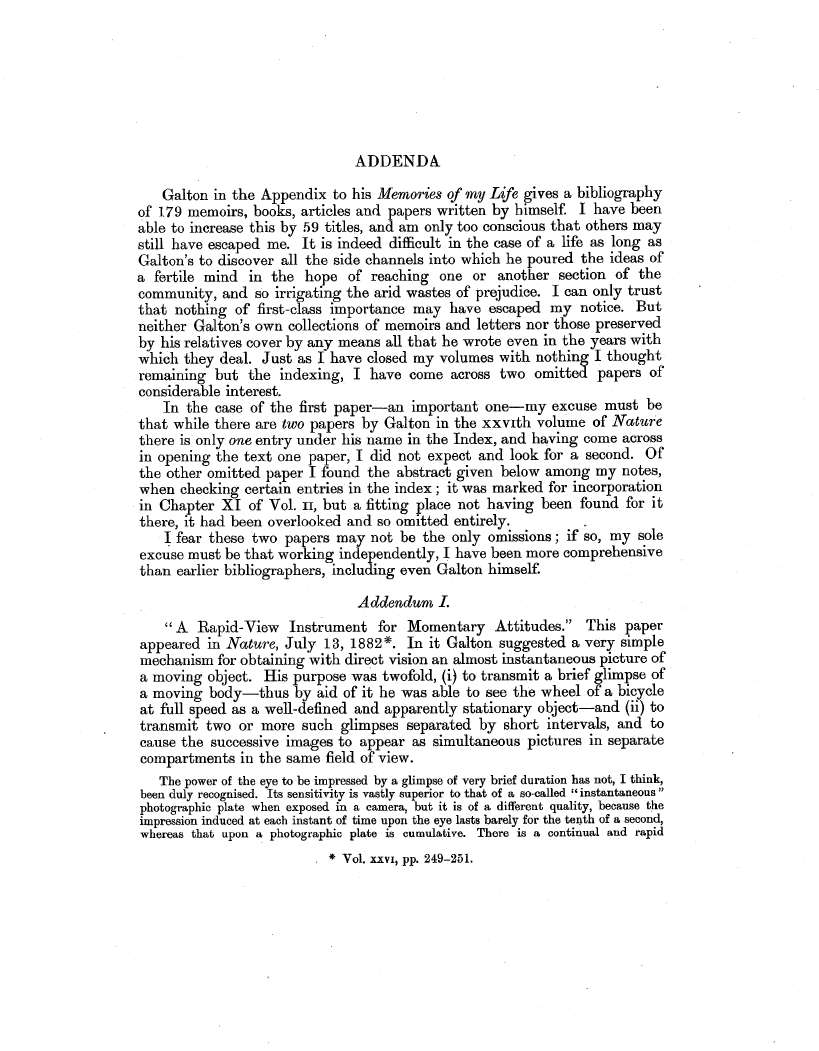| ||||||

OCR Rendition - approximate
ADDENDA Galton in the Appendix to his Memories of my Life gives a bibliography of 1.79 memoirs, books, articles and papers written by himself. I have been able to increase this by 59 titles, and am only too conscious that others may still have escaped me. It is indeed difficult in the case of a life as long as Galton's to discover all the side channels into which he poured the ideas of a fertile mind in the hope of reaching one or another section of the community, and so irrigating the arid wastes of prejudice. I can only trust that nothing of first-class importance may have escaped my notice. But neither Galton's own collections of memoirs and letters nor those preserved by his relatives cover by any means all that he wrote even in the years with which they deal. Just as I have closed my volumes with nothing I thought remaining but the indexing, I have come across two omitted papers of considerable interest. In the case of the first paper-an important one-my excuse must be that while there are two papers by Galton in the xxvith volume of Nature there is only one entry under his name in the Index, and having come across in opening the text one paper, I did not expect and look for a second. Of the other omitted paper I found the abstract given below among my notes, when checking certain entries in the index ; it was marked for incorporation in Chapter XI of Vol. ii, but a fitting place not having been found for it there, it had been overlooked and so omitted entirely. I fear these two papers may not be the only omissions ; if so, my sole excuse must be that working independently, I have been more comprehensive than earlier bibliographers, including even Galton himself. Addendum I. " A Rapid-View Instrument for Momentary Attitudes." This paper appeared in Nature, July 13, 1882*. In it Galton suggested a very simple mechanism for obtaining with direct vision an almost instantaneous picture of a moving object. His purpose was twofold, (i) to transmit a brief glimpse of a moving body-thus by aid of it he was able to see the wheel of a bicycle at full speed as a well-defined and apparently stationary object-and (ii) to transmit two or more such glimpses separated by short intervals, and to cause the successive images to appear as simultaneous pictures in separate compartments in the same field of view. The power of the eye to be impressed by a glimpse of very brief duration has not, I think, been duly recognised. Its sensitivity is vastly superior to that of a so-called °1 instantaneous " photographic plate when exposed in a camera, but it is of a different quality, because the impression induced at each instant of time upon the eye lasts barely for the tenth of a second, whereas that upon a photographic plate is cumulative. There is a continual and rapid 1 Vol. xxvi, pp. 249-251.
|